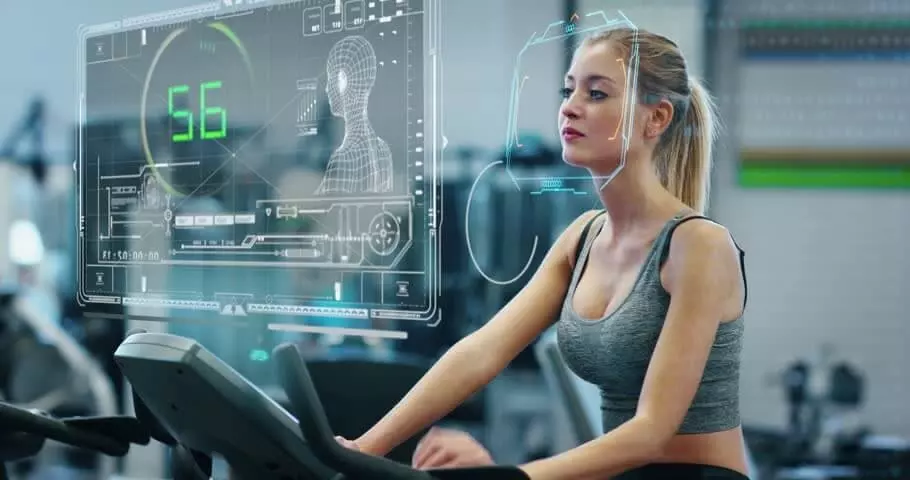Technologies such as artificial intelligence, machine learning and the internet of things can improve our health.
Existing fitness technology is helping us become healthy and more active.
Technology, while offering us ever-increasing levels of convenience and comfort, is often also held responsible for making people obese and unhealthy. Elevators, escalators, and vehicles are a few examples of how technology has not only significantly minimized our need to exert effort, but is also in a way, making people unhealthy. People prefer using motor vehicles even for short distances or to carry out their daily activities like going to a nearby market. Physical activities that used to be a part of our daily lives have been reduced to a great extent. Video games, televisions, and smartphones have made people stick to their homes and stay indoors, rather than going out and socializing. However, these statements do not paint the entire picture when it comes to the impact of technology. People have started realizing the adverse effects of technology and have also started putting technology to good use. Innovations are underway to help people become healthier with the help of the various applications of fitness technology.

1. Fitness Technology & The Internet of Things Are Designing Better Workouts
A fitness trend that is highly prevalent these days is wearable technology. Primarily, it is used to track the user’s health over time. Such devices, at first, were simple individual devices like heart rate monitors, pedometers, or calorie counters but have now evolved into advanced systems that can connect to the internet and sync with users’ mobile phone, where all the collected data can be stored. Users can view their health and fitness data, set targets for themselves, check for progress, and also get rewarded when they achieve their targets. These devices are among the many cool real-life applications of IoT.
2. Smart Watches Are Monitoring Our Health
Smartwatches are all the rage among people, especially the youth, these days. Smart watches are popular because they pack a multitude of functions in a compact, wearable form. These watches come with an inbuilt pedometer to not just count the number of steps taken but also to calculate the total distance traveled. Select smartwatches also have heart rate monitors installed in them to track the heart rate of a person and report any abnormalities. If the wearer’s heart rate goes abnormal, their doctor can automatically be notified through their cellphone. Sleep trackers gather information about how much time a user sleeps in a day and also measures the quality of sleep experienced. All this data is synced to the user’s account through mobile phones and saved for future reference.
3. Wearable Swimsuits Can Record Our Performance
Another piece of wearable technology is a smart swimsuit. The suit, while being cost effective also synchronizes the data automatically like other wearable technologies. It starts capturing data as soon as it is worn. The suit captures the distance covered and the time taken while swimming. This data can be used by sports analysts for research purposes or by swimmers to track their own records.
4. Machine Learning Devices Can Motivate Us to Exercise
Apart from wearable devices, there are also some applications that help motivate and engage users to take better care of their health, both mental and physical. To help with physical health, these apps give users timely reminders to complete their daily exercise goals. If completed, users earn badges or points, which further encourage them to complete their goals. For example, an app with a step counter will have a goal for a specific number of steps to be completed in a day. Once you get past that milestone you’ll be rewarded according to the grading system followed by the app. Rewards, though virtual, encourage users to complete their goals daily and keep them engaged with the activity. Since people are addicted to social media these days, users also get to share their achievements on social media.
5. Continuous Glucose Monitors (CGM) Enhance Diabetic Care
Continuous Glucose Monitors (CGM) represent a revolutionary step forward in managing diabetes. These devices offer round-the-clock blood sugar monitoring without the need for traditional finger-prick tests. By wearing a small sensor on the body, individuals can receive real-time glucose readings sent directly to a smartphone or dedicated device. This constant stream of data allows for better blood sugar management, warning of highs and lows before they become dangerous. CGMs have made a significant impact on the quality of life for diabetics, offering a more flexible approach to managing the condition and reducing the risk of complications associated with erratic glucose levels. You can find more info on continuous glucose monitors (CGM) by doing an online search or consulting with a medical professional. If you or someone you know has diabetes, don't hesitate to look into this technology as a potential tool for better health.
6. Modern Tools Are Relieving Our Stress
Mental illnesses have become very common these days but usually, go unnoticed until it’s too late. One cannot look at a person and find out whether that person is mentally ill or not. Also, people usually have the tendency to not share their mental state with anyone, and hence problems like these usually go unreported, undiagnosed, and thus untreated. Research shows that in America, one in every five adults lives with a mental illness of some type. Thus, it is highly possible that you know someone who is mentally ill due to stress or other reasons and you are not even aware of it. However, the increasing use of technology in the future of mental health treatment is giving hope to people suffering from mental illnesses. Applications are being developed to diagnose and treat people who feel mentally ill. Stress detector apps monitor the behavioral patterns of the users, along with any changes over time. Severe changes in behavioral patterns may prompt the application to notify the user to connect to a counselor or healthcare professional. People these days prefer a mobile application rather than an in-person appointment because an application is much more convenient and also respects an individual’s privacy. Such apps help a user if she prefers to be anonymous. The user can start the treatment anywhere, which is helpful for someone who is uncomfortable with in-person appointments. Usually, these applications are free of cost or have minimal fees involved. A professional might not be able to reach or cover remote areas, but with the help of these applications, even the remote areas can be covered. A major advantage is that a professional may not be available 24x7 but an application can help you even in the middle of the night, which is a very common time when people suffering from depression and anxiety have negative thoughts.
7. Artificial Intelligence Can Monitor Our Diet
AI is being used in healthcare extensively to work as a nutritionist, to create medicinal drugs, to track the medical history of patients, and to do much more. AI can track a user’s diet and lifestyle by monitoring their food intake and daily activities. Using this information, AI can suggest the changes a user needs to make to transform her lifestyle into a healthy one. The user just needs to provide some specific details like the diet being followed, the sleep pattern, and other regular habits. AI monitors them and suggests the best possible plan to get the user en route to the target set.
8. New Medicinal Drugs Can be Made Cheaper
AI has always been, and will always be, an excellent mining tool due to its ability to analyze and find patterns in large datasets. AI can identify the relationship between patterns and data points that might never be identified by human researchers. Using AI patterns, trends can be recognized easily and hypotheses can be created much faster than human researchers. For the above reasons, artificial intelligence is changing drug discovery.
xpensive parts of the drug development process like decision making in clinical trials and real-time clinical monitoring can be improved by AI. AI is also being used to identify potential risks for people by accessing data relating to clinical, genomic, social, environmental, and behavioral factors before they develop full-blown diseases, saving healthcare costs. Two of the biggest players in the field of AI, Google’s Deepmind and IBM’s Watson are performing research in partnership with various pharmaceutical companies and clinical organizations, and are helping researchers save a lot of time. Using the sample data provided, various drug combinations are discovered and using predictive analysis, AI systems also predict the effects that the newly discovered drug may have.
It is true that overindulgence in and overreliance on certain forms of technology, such as social media, television, smartphones, and video games are leading to a deterioration in the health of the people partaking in them. However, it is unfair to solely blame technology for health problems, since most of them can be easily avoided through control and the practice of healthy habits. Similarly, it is also unfair to disregard the advances in healthcare and fitness technology that have increased the life expectancy of people across the world, while evaluating the cumulative impact of technology on our lives. Hence, it is only fair to conclude, albeit tritely, that it is not the technology but our habits that are making us unhealthy, and that technology can, in fact, make us healthier.



Leave your comments
Post comment as a guest